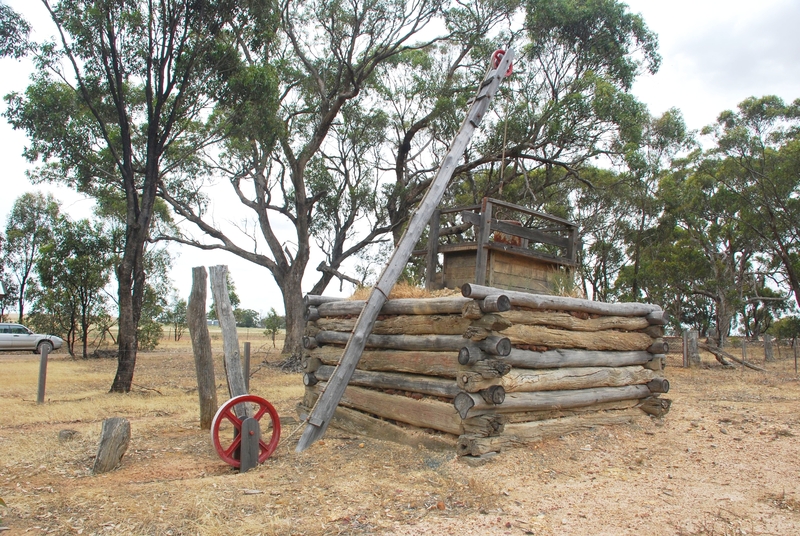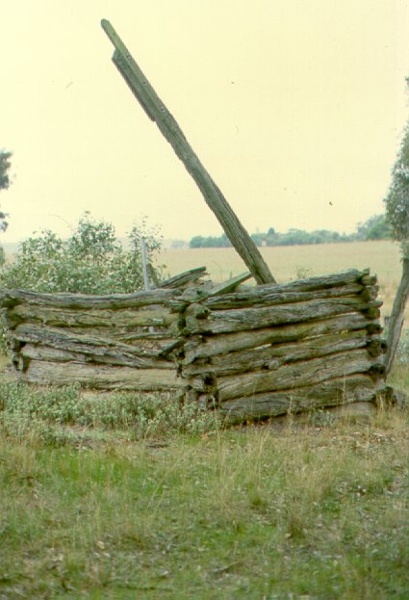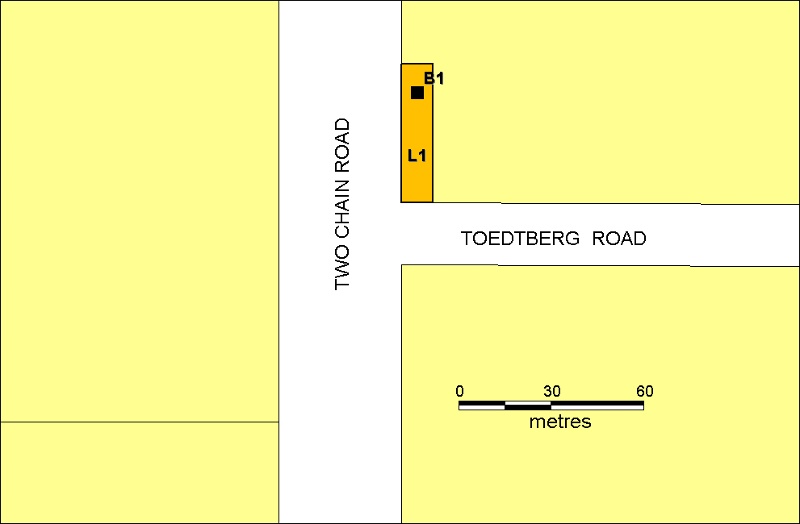COLBINABBIN COMMUNITY WELL
TOEDTBERG ROAD AND TWO CHAIN ROAD COLBINABBIN, CAMPASPE SHIRE
-
Add to tour
You must log in to do that.
-
Share
-
Shortlist place
You must log in to do that.
- Download report




Statement of Significance
The Colbinabbin Community Well consists of a raised earth-filled platform retained by notched logs along with remains of decking. Angled above the well is a whip pole. Nearby are remnants of a tank stand. The whips iron pulley wheels have recently been removed from the site. Knowledge and understanding of the well comes mainly from the shared memories of the Colbinabbin community. Local residents place the wells construction to drought conditions during the 1860s and 1870s and recall two phases of use. The first when buckets were drawn by a haulage device known as a whip, a simple device consisting of a long rope attached to a horse and run down the shaft via a pulley attached to a long pole. As the horse was led away from the hole the bucket was raised. Community use of the well can be traced back to at least 1893 when the Shire of Waranga acquired the well and a small parcel of land surrounding it. Local residents, usually during drought times, purchased water from the well. By the 1920s whip haulage had been abandoned and water was being pumped from the well by an internal combustion engine. The well collapsed in the 1950s and was abandoned.
How is it significant?
The Colbinabbin Community Well is of historical and technological significance to the State of Victoria.
Why is it significant?
The Colbinabbin Community Well is historically significant as a rare example of a once plentiful type. Wells, soaks, tanks and dams were common water supply infrastructure for early settlers. The survival of what was probably the wells first form of water hauling technology, the whip pole, provides the place with a remarkable integrity. Despite the whip being replaced by pump and engine, it was not removed.
The Colbinabbin Community Well is of technological significance mainly due to the survival of a relatively well preserved hauling whip. There are only two other recorded examples of early whips surviving in Victoria, both of which are associated with gold mining shafts. The Colbinabbin whip appears to be the oldest and one of the best surviving illustrations of a technology that was once prevalent throughout Victoria.
-
-
COLBINABBIN COMMUNITY WELL - Assessment Against Criteria
Criterion A
The historical importance, association with or relationship to Victoria's history of the place or object.Criterion B
The importance of a place or object in demonstrating rarity or uniqueness.Criterion C
The place or object's potential to educate, illustrate or provide further scientific investigation in relation to Victoria's cultural heritage.Criterion D
The importance of a place or object in exhibiting the principal characteristics or the representative nature of a place or object as part of a class or type of places or objects.Criterion E
The importance of the place or object in exhibiting good design or aesthetic characteristics and/or in exhibiting a richness, diversity or unusual integration of features.Criterion F
The importance of the place or object in demonstrating or being associated with scientific or technical innovations or achievements.Criterion G
The importance of the place or object in demonstrating social or cultural associations.Criterion H
Any other matter which the Council considers relevant to the determination of cultural heritage significanceCOLBINABBIN COMMUNITY WELL - Permit Exemptions
General Exemptions:General exemptions apply to all places and objects included in the Victorian Heritage Register (VHR). General exemptions have been designed to allow everyday activities, maintenance and changes to your property, which don’t harm its cultural heritage significance, to proceed without the need to obtain approvals under the Heritage Act 2017.Places of worship: In some circumstances, you can alter a place of worship to accommodate religious practices without a permit, but you must notify the Executive Director of Heritage Victoria before you start the works or activities at least 20 business days before the works or activities are to commence.Subdivision/consolidation: Permit exemptions exist for some subdivisions and consolidations. If the subdivision or consolidation is in accordance with a planning permit granted under Part 4 of the Planning and Environment Act 1987 and the application for the planning permit was referred to the Executive Director of Heritage Victoria as a determining referral authority, a permit is not required.Specific exemptions may also apply to your registered place or object. If applicable, these are listed below. Specific exemptions are tailored to the conservation and management needs of an individual registered place or object and set out works and activities that are exempt from the requirements of a permit. Specific exemptions prevail if they conflict with general exemptions. Find out more about heritage permit exemptions here.Specific Exemptions:General Conditions:
1. All exempted alterations are to be planned and carried out in a manner which prevents damage to the fabric of the registered place or object.
2. Should it become apparent during further inspection or the carrying out of alterations that original or previously hidden or inaccessible details of the place or object are revealed which relate to the significance of the place or object, then the exemption covering such alteration shall cease and the Executive Director shall be notified as soon as possible.
3. If there is a conservation policy and plan approved by the Executive Director, all works shall be in accordance with it.
4. Nothing in this declaration prevents the Executive Director from amending or rescinding all or any of the permit exemptions.
5. Nothing in this declaration exempts owners or their agents from the responsibility to seek relevant planning or building permits from the responsible authority where applicable.
* minor repairs and maintenance that replace like with like
* emergency and safety works
* access and fencing works to restrict vehicular access to the site and minimise removal of machinery and foot traffic near or on foundations
* installation of information signage for interpretation and public risk purposes
* control of pest plants and animalsCOLBINABBIN COMMUNITY WELL - Permit Exemption Policy
The Colbinabbin Community Well is a rare survivor. At the time of registration it was in fairly poor condition. Its construction is simple and repairs which replace like with like should be able to undertaken. However, every attempt should be made to retain early fabric wherever practicable. It is desired to retain the essential character of the place while allowing for the normal day to day management of the site and recognising the relative remoteness of the place.
-
-
-
-
-
COLBINABBIN COMMUNITY WELL
 Victorian Heritage Register H1937
Victorian Heritage Register H1937
-
'Boonderoo', House and Outbuildings
 Greater Bendigo City
Greater Bendigo City -
'Riverslea' house
 Greater Bendigo City
Greater Bendigo City -
1 Adam Street
 Yarra City
Yarra City
-
-










